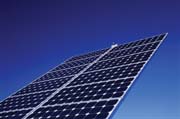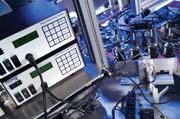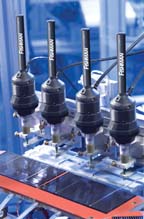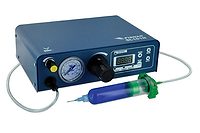
Evergreen Solar is in the business of converting sunlight to electricity. The Marlboro, MA, company is a developer and manufacturer of photovoltaic (PV) modules for home and commercial use. Two basic series of modules are offered: one with 72 cells and one with 36 cells. End-use applications for the solar-generated electric power range from a 50-watt system installed on the roof of a dwelling in the Dominican Republic to an 85 kW solar pyramid on top of the World Trade Center in Tokyo. The most notable customer is the White House, where solar panels are used as a source of electricity.
Production of solar cells by Evergreen Solar is based on a proprietary process for growing crystalline silicon strips 250-300 microns thick, a technology known as string ribbon.
"The strips are continuously grown three inches wide," explains Randy Rotermund, director of Supply Chain Management. "We rough cut them into 6 ft. lengths with a scribing pen, and then laser cut them into 6-inch-long p-type wafers."
The wafers are subjected to a number of processes to convert them into a photovoltaic cell, including diffusing phosphorus into the top surface of each wafer to create the junction, etching the phosphorous glass film that forms on the wafers during diffusion, and applying a silicon nitride anti-reflective coating to the front of the wafer by chemical vapor deposition (CVD).
"These are processes that we understand very well," Rotermund says. "Our overriding concern each step of the way is to ensure precision and quality during manufacture ... and ultimately, consistent electrical performance from cell to cell within a panel. To do this, we have custom designed and built most of the automated equipment stations on our production line."
In initially setting up the line, however, there was one particular challenge.
Scott Danielson, technical manager for Cell Processing, was involved in solving the problem. "After the CVD coating is applied, we fuse a silver pattern on the top side of the wafer and an aluminum-silver pattern on the bottom side," he says. "The bottom side pattern essentially masks the surface of the wafer, except for six square contact points. After testing the wafers to measure output efficiency*, we install solder-coated wire strips across the circuitry on the topside, and then reflow the solder with a heat gun. The strips extend beyond the wafers so as to provide a means of linking cells together. Here's where we originally had some concerns."
* Cell efficiency is the amount of electricity generated by a controlled amount of light, calculated as a percentage of the light energy. Cell efficiency typically ranges from 13-15%, and is measured by exposing the cell to a controlled amount of light referred to as a "solar sun." In assembling modules, Evergreen Solar selects cells with similar efficiencies for each panel.

Unfortunately, conventional dispensing systems, which depend on pulsed air to push the solder paste through the syringe and out of the dispensing tip, were unsuitable. While such pneumatic pumps (also known as time/pressure pumps) can achieve the required dot size initially, the amount of solder paste - and hence, dot size - begins to vary as the temperature, homogeneity and viscosity of the material changes under the pulsing of the air. The solder and flux may even separate out. Also, the quality of the shop air-such as pressure and moisture content-can impact performance.
"We need a level of repeatability that a pneumatic dispenser can't give us," Danielson says.
After investigating various possibilities, Evergreen Solar selected an AirFreeTM dispensing pump developed by Fishman Corp. Actually, the company selected four LDS 9000 pumps and mounted them side by side in a housing to optimize assembly line throughput.

As a result of the precisely controlled rotation of the lead screw, the piston pushes exact and repeatable amounts of solder paste through the syringe and dispensing tip. Once the system is calibrated, the control unit automatically calculates the distance the piston must travel for the volume of solder paste required. The dispensing operation is the same each time, regardless of the viscosity. After a dot of solder paste is dispensed, a programmable pullback of the piston prevents fluid ooze.
"In our opinion, the Fishman dispenser overcomes the drawbacks of a pneumatic system," Rotermund says. "We've also minimized our material and operating costs.
"Because of the design of the LDS 9000, the syringes we get from Fishman are three-quarters filled with solder paste, while the syringes for pneumatic dispensers can be only half filled. Yet the syringe price is about the same.
"That's part of the story," Rotermund explains. "Including less waste, almost no rejects, and less downtime in switching out syringes, we figure our costs are some 70% less than what we would be paying with pneumatic dispensers."
With more than 40,000 panels shipped to date, the savings have quickly added up for Evergreen Solar.
For more information about dispensing, call (800) 433-2115 or visit http://www.fishmancorp.com .
